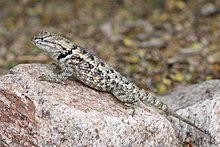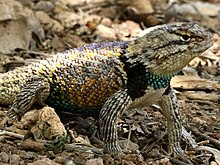
The Phrynosomatidae are a diverse family of lizards, sometimes classified as a subfamily (Phrynosomatinae), found from Panama to the extreme south of Canada. Many members of the group are adapted to life in hot, sandy deserts, although the spiny lizards prefer rocky deserts or even relatively moist forest edges, and the short-horned lizard lives in prairie or sagebrush environments. The group includes both egg-laying and viviparous species, with the latter being more common in species living at high elevations.

Spiny lizards is a common name for the genus Sceloporus in the family Phrynosomatidae. The genus is endemic to North America, with various species ranging from New York, to Washington, and one occurring as far south as northern Panama. The greatest diversity is found in Mexico. This genus includes some of the most commonly seen lizards in the United States. Other common names for lizards in this genus include fence lizards, scaly lizards, bunchgrass lizards, and swifts.

The western fence lizard is a common lizard of Arizona, New Mexico, California, Idaho, Nevada, Oregon, Utah, Washington, Northern Mexico, and the surrounding area. As the ventral abdomen of an adult is characteristically blue, it is also known as the blue-belly.
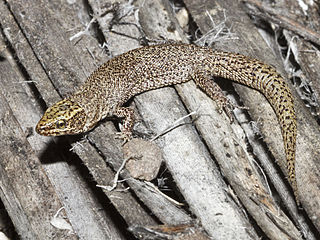
The desert night lizard is a night lizard native to the Southern California Eastern Sierra and the San Gabriel Mountains into Baja California, southern Nevada, southwestern Utah and extreme western areas of Arizona.
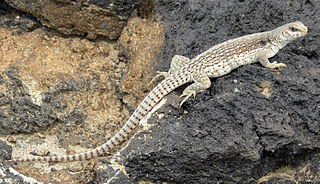
The desert iguana is an iguana species found in the Sonoran and Mojave Deserts of the Southwestern United States and northwestern Mexico, as well as on several Gulf of California islands.

The sagebrush lizard or sagebrush swift is a common species of phrynosomatid lizard found at mid to high altitudes in the western United States. It belongs to the genus Sceloporus in the Phrynosomatidae family of reptiles. Named after the sagebrush plants near which it is commonly found, the sagebrush lizard has keeled and spiny scales running along its dorsal surface.

The western long-tailed brush lizard is a species of lizard in the family Phrynosomatidae. The species is native to the southwestern United States and adjacent northern Mexico.

Aridoamerica denotes a cultural and ecological region spanning Northern Mexico and the Southwestern United States, defined by the presence of the drought-resistant, culturally significant staple food, the tepary bean. Its dry, arid climate and geography stand in contrast to the verdant Mesoamerica of present-day central Mexico into Central America to the south and east, and the higher, milder "island" of Oasisamerica to the north. Aridoamerica overlaps with both.

Sceloporus malachiticus, the emerald swift or green spiny lizard, is a species of small lizard in the Phrynosomatidae family, native to Central America.

Slevin's bunchgrass lizard is a species of lizard in the family Phrynosomatidae. The species is indigenous to the southwestern United States and adjacent northern Mexico.

The southwestern fence lizard, also known as Cowles' prairie lizard, the White Sands prairie lizard or the White Sands swift, is species of spiny lizard in the family Iguanidae. The species is native to the Chihuahuan Desert of the south-western United States and north-central Mexico. Originally described in 1956 as Sceloporus undulatus cowlesi, a subspecies of the eastern fence lizard, subsequent DNA studies elevated the southwestern fence lizard to species status.

Sceloporus uniformis, also known as the yellow-backed spiny lizard, is a reptile of the family Phrynosomatidae. It is native to the Mojave and Great Basin deserts. Until recently, it was considered to be a subspecies of Sceloporus magister.

Sceloporus jarrovii, also known commonly as Yarrow's spiny lizard, is a species of lizard in the family Phrynosomatidae. The species is native to the southwestern United States and northern Mexico. There are two recognized subspecies.

The plateau fence lizard is a species of spiny lizard in the family Phrynosomatidae.
The Sonoran horned lizard, also known commonly as Goode's desert horned lizard and el camaleón de Sonora in Mexican Spanish, is a species of horned lizard in the family Phrynosomatidae. The species is native to Arizona in the United States and to Sonora in Mexico.

Sceloporus clarkii, Clark's spiny lizard, is a species of lizard in the family Phrynosomatidae. It is found in New Mexico and Arizona in the United States and Mexico.

Sceloporus cyanogenys, the bluechinned roughscaled lizard or blue spiny lizard, is a species of lizard in the family Phrynosomatidae. It is found in Texas in the United States and Mexico.
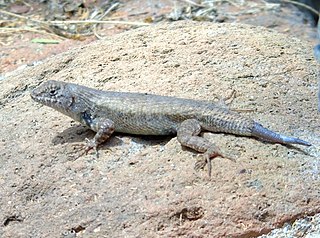
Sceloporus nelsoni, Nelson's spiny lizard or southern Nelson's lizard, is a species of lizard in the family Phrynosomatidae. It is endemic to Mexico. This species contains 2 further subspecies, Sceloporus nelsoni barrancarum and Sceloporus nelsoni nelsoni.
Sceloporus taeniocnemis, also known commonly as the Guatemalan emerald spiny lizard and la chachapaja in Spanish, is a species of lizard in the family Phrynosomatidae. The species is native to Guatemala and adjacent southeastern Mexico. There are two recognized subspecies.
"Desert Spiny Lizard." Arizona-Sonora Desert Museum. Craig Ivanyi. Web.23 Mar. 2015 "Lizards." Reptiles & Amphibians Of The West (1974): 28. Science Reference Center. Web. 23 Mar. 2015. Brennan, Thomas C. "Desert Spiny Lizard (Sceloporus Magister) - Reptiles of Arizona." Desert Spiny Lizard (Sceloporus Magister) - Reptiles of Arizona. N.p., 2008. Web. 13 May 2015.
